Difficult Riddle
-
Also known as Hempel’s Paradox, for the German logician who proposed it in the mid-1940s, the Raven Paradox begins with the apparently straightforward and entirely true statement that “all ravens are black.”
The paradox here is that Hempel has apparently proved that seeing an apple provides us with evidence, no matter how unrelated it may seem, that ravens are black. It’s the equivalent of saying that you live in New York is evidence that you don’t live in L.A., or that saying you are 30 years old is evidence that you are not 29. Just how much information can one statement actually imply anyway?
View SolutionSubmit Solution- 1,445.0K views
- 1 answers
- 0 votes
-
In his final written work, Discourses and Mathematical Demonstrations Relating to Two New Sciences (1638), the legendary Italian polymath Galileo Galilei proposed a mathematical paradox based on the relationships between different sets of numbers. On the one hand, he proposed, there are square numbers—like 1, 4, 9, 16, 25, 36, and so on. On the other, there are those numbers that are not squares—like 2, 3, 5, 6, 7, 8, 10, and so on. Put these two groups together, and surely there have to be more numbers in general than there are justsquare numbers—or, to put it another way, the total number of square numbers must be less than the total number of square and non-square numbers together. However, because every positive number has to have a corresponding square and every square number has to have a positive number as its square root, there cannot possibly be more of one than the other.
Confused? You’re not the only one. In his discussion of his paradox, Galileo was left with no alternative than to conclude that numerical concepts like more, less, or fewer can only be applied to finite sets of numbers, and as there are an infinite number of square and non-square numbers, these concepts simply cannot be used in this context.
View SolutionSubmit Solution- 1,445.2K views
- 1 answers
- 1 votes
-
Imagine a fletcher (i.e. an arrow-maker) has fired one of his arrows into the air. For the arrow to be considered to be moving, it has to be continually repositioning itself from the place where it is now to any place where it currently isn’t. The Fletcher’s Paradox, however, states that throughout its trajectory the arrow is actually not moving at all. At any given instant of no real duration (in other words, a snapshot in time) during its flight, the arrow cannot move to somewhere it isn’t because there isn’t time for it to do so. And it can’t move to where it is now, because it’s already there. So, for that instant in time, the arrow must be stationary. But because all time is comprised entirely of instants—in every one of which the arrow must also be stationary—then the arrow must in fact be stationary the entire time. Except, of course, it isn’t.
View SolutionSubmit Solution- 1,445.6K views
- 1 answers
- 1 votes
-
To solve the puzzle read the riddle and answer the clues below to find each word. Then place the letters on the lines below. Each letter must be placed on a line marked by the same number. When all the lines are full, the answer to the riddle is revealed. Riddle: What do you get from a pampered cow?
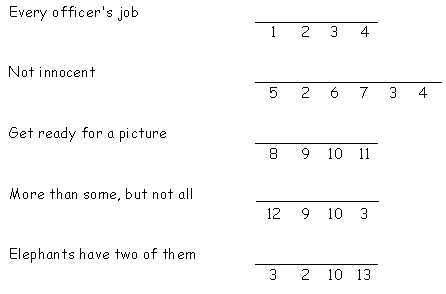

 View SolutionSubmit Solution
View SolutionSubmit Solution- 1,443.5K views
- 1 answers
- 0 votes
-
Find a 4-letter word for each blank below so that when added, two new words (sharing the same middle word) are created. What is each word?
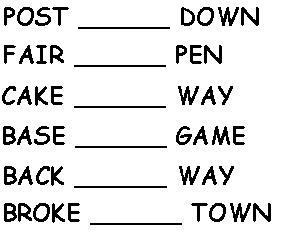 View SolutionSubmit Solution
View SolutionSubmit Solution- 1,442.0K views
- 1 answers
- 0 votes
-
Five friends from across the United States planned to meet at a convention in Milwaukee. Each friend came from a different city and each was employed in a different profession. Use the clues to determine the full name of each friend, their home city, and each one’s profession.
- The doctor and Mr. Cross both arrived a day early.
- By coincidence, the secretary from San Diego and the doctor, Ms. Forest, arrived at the hotel together.
- The lawyer arrived late. He was delayed by a case and had to catch a later flight from Baltimore.
- Jane, Mr. Smith, Mark, the mechanic, and the friend from Chicago all planned to spend the weekend after the convention together. Then on Monday, Ms. Trent and Tom would leave to return to work. Dan, the teacher, and Cindy would leave on Tuesday.
- Dan Richards does not live in Baltimore. Cindy does not live in St. Louis.
- Ms. Trent laughed when asked if she was a teacher. “No, he’s from Atlanta,” she said. “I’m from San Diego.”
View SolutionSubmit Solution- 1,442.7K views
- 1 answers
- 0 votes
-
One day, five couples and their children (each couple had only one child) spent the day at an amusement park. They all enjoyed the day tremendously despite the fact that each child managed to get lost at some point during the day. Using the clues and the grids below, determine the full name of each couple, the name and age of each couple’s child, and where each lost child was found.
- George, whose last name isn’t Smith, is a good friend of Bill Walker, who is not Susie’s father.
- The ages of the children from lowest to highest are the 6 year old, Ann, the one found by the teacups, George’s son, and Jane’s child.
- Michael Charming, whose 10-year-old child is the oldest, helped Stan find his daughter, who is a year younger than Ann, by the carousel. Stan’s last name isn’t Smith.
- The boy found at the ferris wheel is younger than John but older than Ann. Mary is older than Susie but younger than Tom.
- Sally Jackson didn’t find her son at the teacups or the roller coaster. When she looked by the flume, she found Kim’s 7-year-old child.
- Al and Linda’s child, who is 8, is the best friend of Michelle’s daughter, who is two years younger.
Use the grid to help solve the puzzle!
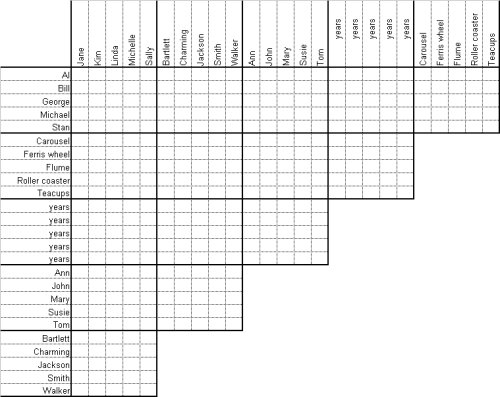 View SolutionSubmit Solution
View SolutionSubmit Solution- 1,442.6K views
- 1 answers
- 0 votes
-
Five bachelors who all lived in the same apartment building each ordered an item from the same catalog. Unfortunately, the shippers got confused and each item was delivered to the wrong apartment. Can you determine each man’s full name, what each man ordered and what was actually delivered, and which apartment each man lived in.
- Roger, who doesn’t live in an end apartment, ordered the Television set. Tom lived next door to the man who received the dishware.
- Mr. Weiseman, who didn’t receive the automotive tools, lives two apartments from the man who ordered the downhill skis and one apartment from Harry.
- Ed, whose last name isn’t Smith, lives in apartment #3 but he didn’t receive the automotive tools. Mr. Smith, who doesn’t live in apartment #4, ordered the golf clubs but he received the item that Mr. Campbell ordered, which wasn’t downhill skis.
- The bachelor in apartment #1, which isn’t Tom, ordered what Al received. The man in apartment #2, who didn’t receive the golf clubs, lives next door to where what he ordered was delivered.
- Mr. Bates didn’t order the downhill skis. The television set was not delivered to Ed’s apartment.
- Tom lives in apartment #5.

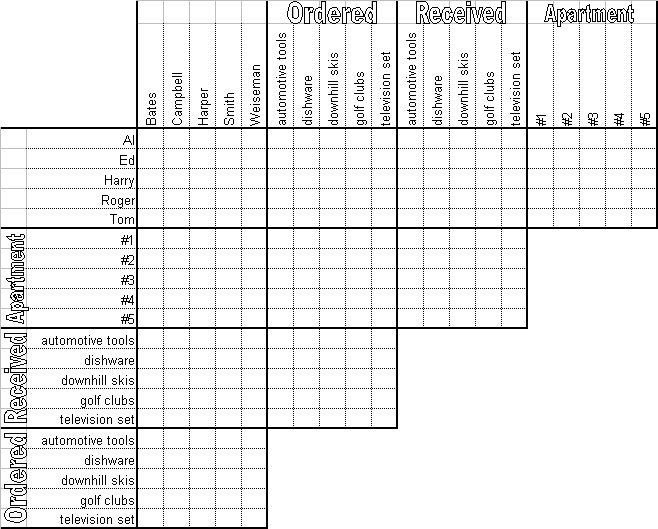 View SolutionSubmit Solution
View SolutionSubmit Solution- 1,442.4K views
- 1 answers
- 0 votes
-
John Farmer woke up one morning to pandemonium in his barnyard. The gate had been left open and the animals had wandered out during the night. When he looked out the window, he could see the chickens and the sheep. By the time he got downstairs he could see the goats, too. But he had to hunt for the cows and the horses. After an hour of running around, Jake finally got all his animals back in their pens. Using the clues below, determine how many of each animal the farmer had to find, what kind of mischief each type of animal got into, and how long it took the farmer to return each group of animals to their pens.
- The animals running loose on the neighbor’s lawn were not the goats.
- The twelve chickens, who were not eating Jake’s vegetable garden, took the most time to return to their pen.
- Jake had five of one type of animal; he had an even number of all the other animals.
- The animals he had the least number of were the ones found in the grain room. The animals he had the most of took him twenty minutes to catch.
- The animals Jake had only two of took five minutes to catch while the animals he had six of took twice as long to catch.
- Jake had six more chickens than goats but two more goats than sheep.
- It took five minutes more to catch the horses than it took to catch the animals in the hay field but getting the horses took five minutes less than collecting the animals scattered around the barnyard.
- It took Jake the same amount of time to collect the four animals in the hay field as it did to collect the goats.
ANIMAL Number of animals Animals’ location time CHICKENS COWS GOATS x HORSES SHEEP x View SolutionSubmit Solution- 1,443.9K views
- 1 answers
- 0 votes
-
Five parents pick-up their children at the Puzzlefry Elementary School every Tuesday to bring the kids to their afterschool activity. Colleen and the four other children all attended a different afterschool activity and their parents always arrive at different times (between 3:00 pm and 3:30 pm). Determine each child’s full name, the first name of the parent picking them up (all the parents’ last names are the same as their child’s), the time each was picked up, and the activity each child is being brought to.
- Margie’s best friend’s mother, Mrs. Dobson, arrived before Cathy came to pick up her son. Mrs. Walsh picked up her daughter for fencing.
- Josh Steinway loved football as much as Donno liked chess, and they both liked being the last two to be picked up.
- David Holden picked up his daughter for her hiking as soon as he could, but Lynne was always there before he was.
- Margie liked being the first one picked up but she didn’t take ballet or hiking.
- Lynne’s daughter was not Margie.
- In order of their departure from school: Ann, the girl who took ballet, Mary Holden, the boy who took football, and Capri Johnson.
Use the grid to solve the puzzle!
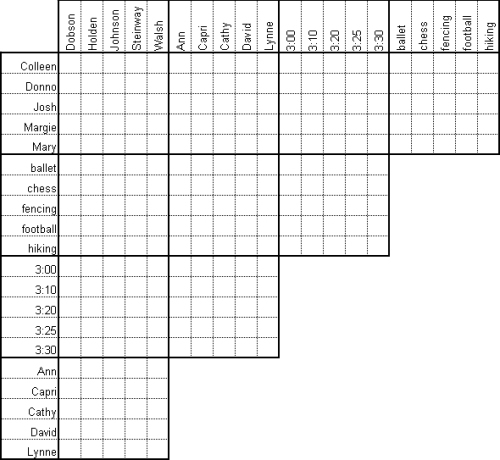 View SolutionSubmit Solution
View SolutionSubmit Solution- 1,443.2K views
- 1 answers
- 0 votes


